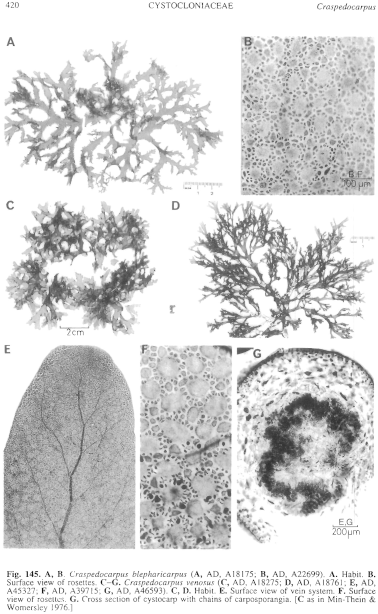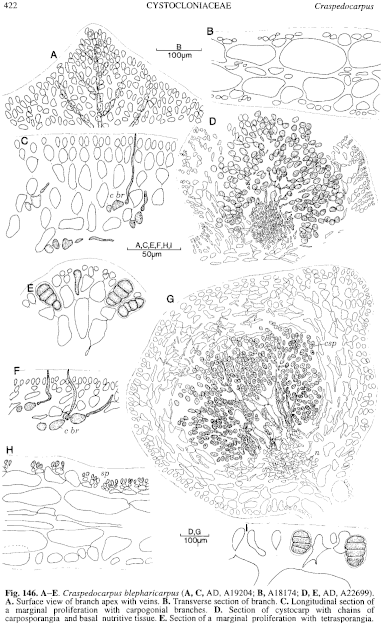|
|
|
|
|
|||||||||||
|
Electronic Flora of South Australia Species Fact Sheet
Phylum Rhodophyta – Class Florideophyceae – Order Gigartinales – Family Cystocloniaceae
Synonym
Rhodophyllis blepharicarpa Harvey 1863: pl. 254. J. Agardh 1876: 365. De Toni 1897: 344. Kylin 1932: 43. Lucas 1929b: 49. Lucas & Perrin 1947: 166, fig. 38. May 1965: 409. Reinbold 1897: 50. NON Kützing 1869: 19, pl. 52a-c (= Jeannerettia crispata ?, based on MEL 44996 with Kützing's annotation).
Thallus (Fig. 145A) erect, 5–10 cm high, complanately and subdichotomously to laterally branched with branches mostly 4–7 mm broad and 150–250 µm thick; branches uniform in width throughout the thallus, apices rounded, and with marginal fringes of simple, terete, proliferations 1–2 mm long and 300–700 µm in diameter. Holdfast discoid, epilithic. Structure uniaxial (Fig. 146A), the subapical cells each producing alternately two periaxial cells, the lateral ones developing the flat branch, and enlarging to form the alternately pinnate vein system (Fig. 146A) (visible microscopically); medulla slight, cortex (Fig. 146B) 2–3 cells thick with large ovoid inner cells and outer rosettes (Fig. 145B), the cells of which may divide and largely cover the inner cells in older branches, terete marginal proliferations with equally developed periaxial cells. Rhodoplasts discoid few to numerous per cell.
Reproduction: Sexual thalli probably dioecious; procarpic. Carpogonial branches (Fig. 146C) 3 (–4)-celled, borne on inner cortical cells in the marginal proliferations, lying almost parallel to the surface with outwardly directed trichogynes. Auxiliary cell adjacent and outward to the supporting cell, becoming darkly staining as do other adjacent cortical cells, and cells inward to the auxiliary cell producing small darkly staining nutritive cells. Gonimoblast initial formed inwardly, with later gonimoblast filaments radiating from a central group of cells (Fig. 146D), producing terminal chains of ovoid carposporangia 12–20 µm in diameter; sterile filaments fusing with pericarp cells, and also with the basal nutritive tissue. Cystocarps (Fig. 146D) in the marginal proliferations, swollen, 450–700 µm in diameter, with a cortical pericarp, non-ostiolate. Spermatangia unknown.
Tetrasporangia (Fig. 146E) scattered in the cortex of the marginal proliferations, ovoid, 18–22 µm in diameter, zonately divided.
Type from Garden and Rottnest Is, W. Aust.; lectotype in Herb. Harvey, TCD (not yet chosen).
Selected specimens: Geraldton, W. Aust. (White, Nov. 1898; MEL, 45002). North Beach, Perth, W. Aust., drift (Norris 1732, 27.iii.1959; AD, A22262). W. Aust. (Clifton; AD, A18174, A18175). Head of Great Australian Bight, S. Aust., drift (Womersley, 4.ii.1954; AD, A19204). Tiparra Reef, Spencer Gulf, S. Aust., 11 m deep on Amphibolis (Shepherd, 13.vii.1971; AD, A39265). Somerton, S. Aust., drift on Amphibolis (Womersley, 29.v.1949; AD, A10831). Encounter Bay, S. Aust. (Cleland; AD, A3722). Dutton Bay, Portland, Vic., drift (Womersley, 13.iv.1959; AD, A22699). Cat Bay, Phillip I., Vic., drift (Womersley, 10.iv.1959; AD, A22728). West Point, Erith I., Bass Strait, 28 m deep (Shepherd & R. Lewis, 10.v.1974; AD, A45250).
Distribution: Geraldton, W. Aust., to Phillip I., Vic., and Erith I., Bass Strait.
Taxonomic notes: Craspedocarpus blepharicarpus is characterised by the marginal fringes of short subterete ramuli bearing the reproductive organs. It occurs mainly in moderate depths under slight to moderate water movement, commonly as an epiphyte on Amphibolis stems.
References:
AGARDH, J.G. (1876). Species Genera et Ordines Algarum. Vol. 3, Part 1 - Epicrisis systematis Floridearum, pp. i-vii, 1–724. (Weigel: Leipzig.)
DE TONI, G.B. (1897). Sylloge Algarum omnium hucusque Cognitarum. Vol. 4. Florideae. Sect. 1, pp. 1–388. (Padua.)
HARVEY, W.H. (1863). Phycologia Australica. Vol. 5, Plates 241–300, synop., pp. i-lxxiii. (Reeve: London.)
KYLIN, H. (1932). Die Florideenordnung Gigartinales. Lunds Univ. Årsskr. N.F. Avd. 2, 28 (8), 1–88, Plates 1–28.
LUCAS, A.H.S. & PERRIN, F. (1947). The Seaweeds of South Australia. Part 2. The Red Seaweeds. (Govt Printer: Adelaide.)
LUCAS, A.H.S. (1929b). A census of the marine algae of South Australia. Trans. R. Soc. S. Aust. 53, 45–53.
MAY, V. (1965). A census and key to the species of Rhodophyceae (red algae) recorded from Australia. Contr. N.S.W. natn. Herb. 3, 349–429.
MIN-THEIN, U. & WOMERSLEY, H.B.S. (1976). Studies on southern Australian taxa of Solieriaceae, Rhabdoniaceae and Rhodophyllidaceae (Rhodophyta). Aust. J. Bot. 24, 1–166.
REINBOLD, T. (1897). Die Algen der Lacepede und Guichen Bay und deren naherer Umgebung (Siid Australien), gesammelt von Dr. A. Engelhart-Kingston. Nuova Notarisia 8, 41–62.
The Marine Benthic Flora of Southern Australia Part IIIA complete list of references.
Publication:
Womersley, H.B.S. (14 January, 1994)
The Marine Benthic Flora of Southern Australia
Rhodophyta. Part IIIA, Bangiophyceae and Florideophyceae (to Gigartinales)
Reproduced with permission from The Marine Benthic Flora of Southern Australia Part IIIA 1994, by H.B.S. Womersley. Australian Biological Resources Study, Canberra. Copyright Commonwealth of Australia.
Illustrations in Womersley Part IIIA, 1994: FIGS 145A, B, 146 A–E.

Figure 145 enlarge
Fig. 145. A, B. Craspedocarpus blepharicarpus (A, AD, A18175; B, AD, A22699). A. Habit. B. Surface view of rosettes. C–G. Craspedocarpus venosus (C, AD, A18275; D, AD, A18761; E, AD, A45327; F, AD, A39715; G, AD, A46593). C, D. Habit. E. Surface view of vein system. F. Surface view of rosettes. G. Cross section of cystocarp with chains of carposporangia. [C as in MM-Thein & Womersley 1976.]

Figure 146 enlarge
Fig. 146. A–E. Craspedocarpus blepharicarpus (A, C, AD, A19204; B, A18174; D, E, AD, A22699). A. Surface view of branch apex with veins. B. Transverse section of branch. C. Longitudinal section of a marginal proliferation with carpogonial branches. D. Section of cystocarp with chains of carposporangia and basal nutritive tissue. E. Section of a marginal proliferation with tetrasporangia. F–I. Craspedocarpus venosus (F, AD, A18761; G, AD, A31574; II, AD, A30164; I, AD, A22698). F. Longitudinal section of cortex with carpogonial branches. G. Longitudinal section of a cystocarp with central unfused cells, chains of carposporangia, and basal nutritive tissue. H. Section of thallus with spermatangia. I. Section of cortex with tetrasporangia. [A–I after Min-Thein & Womersley 1976.]

|
Email Contact: State Herbarium of South Australia |

|